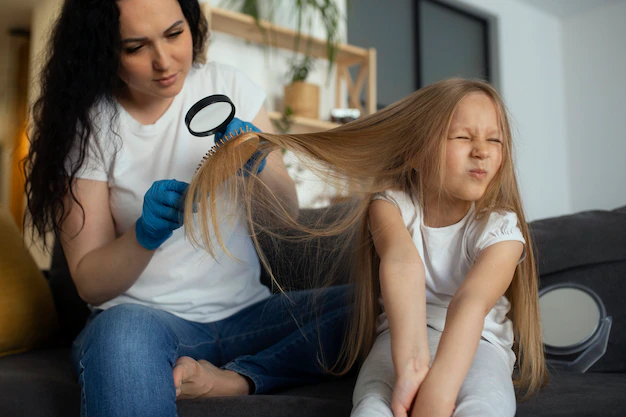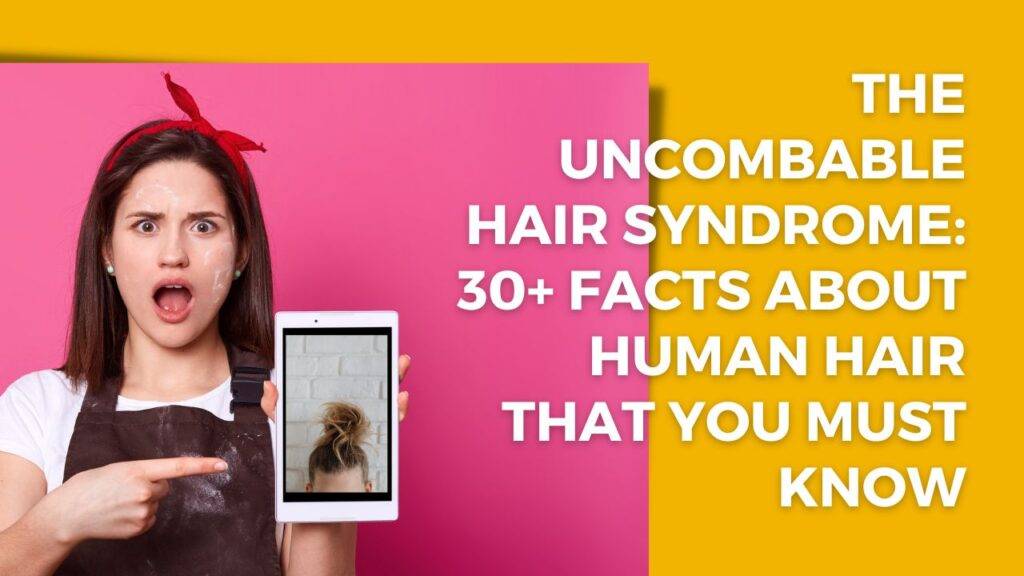Human Hair, for the most part, contains keratin (protein). The hair on our face tends to grow faster than any other body part. Well, aren’t all these human hair facts also interesting and astonishing?
An entire industry is blooming outside based on human hair and its basics. Brands go through an extensive process of trial and error to make it to the consumer’s hair care regime. Not only that, but we also have salons all around the globe giving in extra effort to help their clients with a proper hair care regime and exclusive look all the time.

While it is not always about the adults, parents also take care of their infant’s hair in the best way possible. Then also, a crippling syndrome occurs in the young, and the cause of such an act is the human gene itself. Known as uncombable hair syndrome, where the person in concern has dry and frizzy hair which goes uncombed.
Uncombable Hair Syndrome – Details
The uncombable hair syndrome starts at the very early stages of childhood, e.i, infancy and three years. But also there are instances of the same appearing as late as 12 years. However, the good news is that the condition does wear off over time, and the children as adults have natural hair lying flat.

Uncombable Hair Look And Frequency Of Cases
The uncombable hair syndrome in black hair is uncommon, and children affected usually showcase hair that is light in color or shades of silvery/blond. Their hair gets a glittery sheen. As per the look of the same, this type of hair never grows downward; instead grows in different directions from the main scalp.
Despite the change in the appearance of the same, these hairs are not brittle or fragile. However, the growth rate is slow compared to regular hair. The exact frequency is unknown, and at least a hundred cases have been filed. Uncombable hair syndrome in adults is also normal, and the person is most likely to develop the same in later life.
Cause
Mutations in TGM3, PADI3, or TCHH genes primarily cause uncombable hair syndrome.
Generally, the proteins secreted by TGM3 and PADI3 influence the trichohyalin protein produced by the TCHH-type gene. This modified trichohyalin gets attached to other trichohyalin-based proteins and molecules known as keratin intervening filaments, creating cross-links. The links combine into a dense network structure and offer a cylindrical shape to the hair shaft.
When the PADI3, TCHH, or TGM3 gene gets mutated, it creates proteins with less or no activity. Finally, the hair shaft’s shape gets altered. Common uncombable hair shapes are heart-like, flat cross, or triangular. A single strand of hair can have all these shapes along the entire length. Because the hair has an angular shape, it will never lie flat.
Inheritance
As already discussed, mutations in TGM3, PADI3, and TCHH genes cause uncombable hair syndrome. This is visible in cases where the individual’s parents carry copies of the genes (mutated). The setup in which the syndrome is inherited is autosomal recessive by type. Each parent does have the gene (mutated) without the symptoms and signs of the condition.
30+ Human Hair Facts That You Must Know
Well, that was all the information helping you with uncombable hair syndrome. Moving forward, here are 30+ less-known hair facts about human hair that you must know:
General Human Hair Facts

- Uncombable hair syndrome can also affect adults.
- A man’s beard can grow over 30 feet if he has never shaved.
- Chimpanzees and humans have the same hair follicles per sq. inch of their skin.
- There are chances for wavy hair to shrink by five percent, oily hair can shrink by seventy-five percent, and for curly hair, it is thirty percent.
- Men’s hair tends to grow quicker than women’s.
- A renowned temple in India sets up donated human hair for auction. And the amount earned goes up to 6.39 crore.
- Ninety percent of the hair on the head tends to grow while the other ten percent rest.
- The hair follicle stops producing colored hair once melanin secretion is disturbed.
- Each hair follicle grows new hair about twenty times a lifetime.
- Asian hair is most of the time straight and is either black or dark brown.
Curly Hair Facts

- The modern Britons living 10,000 years ago had curly hair, and we have descended from them.
- Around fifty-six per cent of people in Europe have curly hair.
- In curly hair, the protein builds up on one side of the hair, forming curls.
- Red curly hair is a mutation of the MC1R gene, causing red hair and freckles.
- Girls with curly hair find it hard to maintain the same. And this type of hair could be better at retaining moisture.
- When looking from a distance, curly hair appears to be dull. The natural oils produced by the hair follicles take longer to distribute at the end of the hair.
- People with natural curls find it hard to vouch for a single hair product. That is because the texture, curl type, hair porosity, and other environmental conditions act as deciding factors.
- The number of hair on one’s head is 120,000, while the amount is 100,000 for a person with curly hair.
- One head can have different types of curls.
- The average growth rate of curly hair is six inches a year.
Blonde Hair Facts

- Only two percent of people worldwide have pure blonde hair, which is rare.
- Blonde hair is also a natural side effect of genetic mutation.
- Kids born with blonde hair can later grow darker hair before their tenth birthday. The composition of eumelanin, a natural pigment capable of controlling darkness in hair, grows.
- There are thirty shades of blonde hair. Wait, can you believe it?
- Generally, the number of hair on a person’s head is 120,000. It gets more with a person having light-colored hair or blonde hair. That is because the hair is finer, and the scalp gets to hold more strands.
- Men sometimes misjudge women with blonde hair as needy, neurotic, and high-maintenance.
- Princess Diana had natural ash blond hair.
- During ancient civilizations, people used to associate blond hair with worshipping the goddess of the yellow dawn.
- During Roman Era, emperors used to capture German blonds, shave off their heads and make wigs.
- Finland is the only country with the most number of blonds throughout the entire world. Also, Paraguay has a separate community of blonds.
Straight Hair Facts

- The easiest to manage hair type is straight hair.
- It is easy for natural oils to spread from the scalp to the hair shaft, offering all the nourishment to naturally straight hair.
- Straight hair is less prone to breakage and split ends.
- People with straight hair struggle with enough body hair growth.
- As the sebum from hair is easily visible, people with straight hair needs to wash their head with shampoo more than once a week.
- Straight hair is glossy compared to other hair types.
- Scalps with straight hair are prone to oiliness and greasiness.
- There are three types of straight hair: Type 1A Fine hair, Type 1B Medium hair, and Type 1C Coarse hair.
- Straight hair does lie flat on the scalp and has no volume.
- People often complain that they get minimal styling options with straight hair.
Human hair comes in various textures, colors, and styles depending on the genes and surroundings of the person in concern. However, the natural texture can get affected when not taken care of at the right time.



